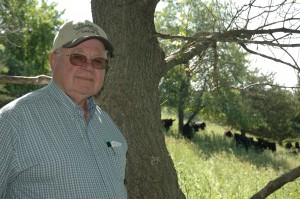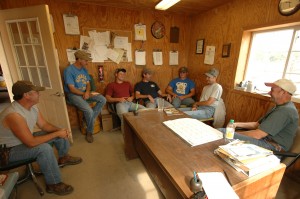
Schiefelbeins divide labor, unify purpose

Frank Schiefelbein II told me that four years ago when I visited his family’s Angus seedstock farm near Kimball, Minn. And although he said it half joking, there must be a bit of truth to that.
I thought about harvest time at my family’s house and the coordination it took to have the right people in the right field at the right time. How in the world do they do it with eight sons and their wives, and more than 30 grandkids?
Fast forward. Just a few weeks ago I got to take in a Schiefelbein family meeting—or maybe I should call it the Schielfelbein morning chat. Meeting sounds awfully formal…..but then again, there is plenty of business to discuss.
What price should they lock in for beet pulp? How is the slat barn addition coming along? Did Tim really just buy a couple hundred head of feeder calves at that price?

After they all talk over the comings and goings for the day and give input on the bigger picture, they disperse. Each brother has a job, from managing risk and futures to crop farming to cattle feeding. I took a tag-team tour of the farm—Danny showed me the carefully mated herd, Tim pulled up carcass data on his computer screen, Frank III explained the new feedlot setup, Don talked about the future direction. In the pickup/office/pasture conversations, one thing rang out.
Each one of “the boys” knows their job and they do it well. Bob oversees the crops, Tom is the head mechanic, and so on.
Yet, they don’t function independently. They all vote on the AI sires they’ll use. They take turns once every three nights pulling overnight shifts in the calving barn.
 Everybody knows that it’s about the end product. Don says his father’s Twin Cities upbringing, formed his simple, but sturdy philosophy: “From day one, dad always said, ‘If we’re in the beef business, we better raise good beef.’”
Everybody knows that it’s about the end product. Don says his father’s Twin Cities upbringing, formed his simple, but sturdy philosophy: “From day one, dad always said, ‘If we’re in the beef business, we better raise good beef.’”
And that’s how Tim was able to show harvest data on customer cattle that reached 40%, 50%, 60% Certified Angus Beef brand and Prime.
So that’s the family secret for making it all work. Shared vision.
Seems like the beef industry could take this message from the Schiefelbeins to heart: everybody has a job to do (think cow-calf, stocker, feeder), and they do it well, but all with the ultimate goal (beef) in mind.
May your bottom line be filled with black ink,
Miranda
You may also like
You, Your Cows and Their Feed
Expert guidance from Dusty Abney at Cargill Animal Nutrition shares essential strategies for optimizing cattle nutrition during droughts, leading to healthier herds and increased profitability in challenging conditions.
Marketing Feeder Cattle: Begin with the End in Mind
Understanding what constitutes value takes an understanding of beef quality and yield thresholds that result in premiums and/or discounts. Generally, packers look for cattle that will garner a high quality grade and have excellent red meat yield, but realistically very few do both exceptionally well.
Kansas Ranchers Recognized for Sustainability Efforts
Kansas’ Wharton 3C Ranch thrives despite droughts, winning the CAB 2023 Sustainability award. The data-driven, quality-focused approach of first-generation ranchers, Shannon and Rusty Wharton, yields 100% CAB cattle. Their commitment to sustainability and industry collaboration sets a bright future for the cattle business.



